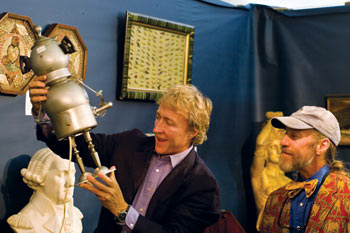October 2010
All of Maine’s a treasure hunt! And Leigh Keno is the ultimate guide to help you score pieces with personality and a past.
Interview by Colin W. Sargent
 You’ve heard the devastating pause on Antiques Roadshow, when dapper Leigh Keno floats over to a frenzied demilune-table owner and dazzles her with, “Have you given any thought to what this might be worth?” Now imagine kidnapping Keno and having him look at your stuff. That’s our situation here, as the celebrated expert has kindly agreed to chat with us exclusively about preeminent examples of Maine antiques as investments.
You’ve heard the devastating pause on Antiques Roadshow, when dapper Leigh Keno floats over to a frenzied demilune-table owner and dazzles her with, “Have you given any thought to what this might be worth?” Now imagine kidnapping Keno and having him look at your stuff. That’s our situation here, as the celebrated expert has kindly agreed to chat with us exclusively about preeminent examples of Maine antiques as investments.
In today’s market, how hot is furniture carved by the father-son team of John and Thomas Seymour, who sailed to Portland from England in 1784 before relocating to Boston in 1793?
I think pieces by the Seymours have held pretty steady. It depends on the object…There are four magic considerations: quality, rarity, condition, and the icing on the cake is provenance. If you have all four, you have a winner. I recently purchased a wonderful Seymour side table with the original marble top and surface for a client, and it’s just incredible–a masterpiece with imported marble, great carving. It was above $250,000, but it was a great buy at that!
What are the fastest ways to tell a Seymour?
We say “a piece made by Seymour.” You should call Robert Mussey, the expert. He’s looked at so many pieces. Do you have his book [The Furniture Masterworks of John and Thomas Seymour]? There were popular motifs used over and over. I was just in Binghamton, where I was fly fishing, and a friend invited me over. He had a Seymour piece and the secondary wood in the drawers was mahogany, with beautiful dovetails.
Is there such thing as a “bad Seymour”?
Not “bad,” but there are some forms made by the Seymours and others that were functional, like a sideboard. Certainly the deeper the case, the shorter the legs. Some have really deep cases and short legs to hold the silver and wine. It’s not beautiful in terms of form, but when you start looking at one of these deep-set pieces and consider the quality of the details, it’s beauty of function.
Can you tell the difference between something created by John Seymour as opposed to Thomas Seymour?
No. We had a sofa table once that was made by John and Thomas, and I checked with Robert, and he confirmed they made it. Later, Thomas moved on, and those pieces you can tell, because he’s working around 1810-1814, making reeded legs and pieces with rounded corners.
There was an incredible inlaid demilune Seymour card table with swags and bellflowers that my brother Leslie and I appraised on Roadshow labeled “John and Thomas Seymour.” The lady had paid $25 for it at a tag sale over 20 years earlier. On the air, Leslie and I said it was $150,000 to $200,000–on a good day, $300,000. Then we said goodbye and went back to appraising pressback chairs and spinning wheels.
Neither of us approached the lady about selling it, but Leslie, who is the Director of American Furniture & Decorative Arts for Sotheby’s, mentioned to his coworkers, “If anybody named Claire calls…”
Then the call came in. There it was–201, the New Jersey area code–and he let out a howl [throughout the office] that was heard all the way down in Medieval Works of Art.
I attended the auction. It went to $300,000. Then $400,000, $420,000, $460,000, $480,000. I think the hammer price with buyer’s premium was $540,000.
Since the economy is so market-driven, are the Portland-era Seymour pieces worth less than their Boston counterparts?
I wouldn’t ever say that. Pieces are very important if they come from Portland because that’s where they started.
Give us a yardstick. If Samuel McIntire of Salem is 100 on an arbitrary scale of furniture-carving excellence, what number would you fix to the Seymours?
I wish you could do that, but on a piece-by-piece basis it changes. The record for a McIntire [may well be below the record for a Seymour piece]. I bought a major McIntire sofa in New York with the carved basket of flowers–everything–in the high $200,000s. In a way, the card table by Seymour was a singular piece.
Does Maine have a separate cachet for its period furniture–a Maine mystique?
I love items made outside urban areas equally, if not more. Painted furniture [for which Maine is famous]–pieces that are a little quirky with their own style–are a favorite of mine.
Why do you think Portsmouth became singularly famous for its brilliant pieces of furniture made from tiger-maple or flaming birch? The almost black mahogany pieces in Salem and Boston are so Calvinistic and severe in comparison. Is there something renegade, or pirate, about Portsmouth?
The difference is night and day. Salem was more influenced by Boston. Salem furniture is, I don’t want to say “sexy,” but a little more exuberant than Boston furniture, which was more reserved. Boston was the style center for the colonies from the late 17th century until about 1750. They were the next best thing to London in terms of style. They were shipping style up and down the coast. I have a sense of this because I’ve spent many a pleasant hour studying the shipping records from Salem up to Portsmouth. I think I could fly fish or do primary research the rest of my life and be totally happy.
What’s most exciting about the antique business right now?
Hopefully, a new wave of young people will learn to mix antique furniture with modern furniture. Leslie and I have created a collection for Theodore Alexander that we call Keno Bros. Furniture. The idea here is, the pieces can be put in any home, appealing to all age demographics. Many of the pieces are designed to complement, say, the curve of a Queen Anne chair or the S-shaped line of a 20th-century moderne dining table, but they are striking and contemporary, with very clean lines and beautiful wood.
We just got back from Vietnam, where we previewed a number of items in the line. What’s singular is we imagine the missing statement piece in a room and suggest it with these modern accompaniments, so you find yourself saying, “You can totally see this next to a Shaker table or Chippendale chest-on-chest.“
It’s hard to exactly define State of Maine furniture other than to say it’s gorgeous, painted, and something you put in front of a Rufus Porter mural. According to legend, all the grain painting stems from the fact that we Mainers are infamously penurious. Only the wealthiest families could purchase mahogany or rosewood with impunity, so indigenous woods from pine to birch, beech, maple, and basswood were disguised to look like something better. Wasn’t it KMart, 18th- and 19th-century style?
Not many names survive of the vernacular artists who did this grain painting and stencilling. There’s a George Lord [1833-1928] who worked in Portland at the Walter Corey furniture factory.
What is “good Maine paint”? For some reason, I’ve never heard an auctioneer say, “bad Maine paint.”
I love that. “Good paint” is original paint with great surface that hasn’t been messed with. I once watched a guy make a pipe box and spray it with automotive paint from a hanging paint box. Then he added baby powder and set it on fire, like flambé, and the powder gave it that bubbled, dry look. It looked so authentic. But how can I tell “good Maine paint”? You can smell it. It’s soft. I have a prominent nose, so I use that.
On Antiques Roadshow, Arlie Sulka, from Portland, is the Tiffany expert–and the heir in terms of collecting intellectual property of all things Tiffany to Lillian Nassau of Manhattan. Do you know Arlie?
She’s adorable. I just had dinner with Arlie and her husband, Andy, in Billings, Montana. She must have been a knockout in high school…so sweet, so knowledgeable. She knows Tiffany. They bought some things at my last auction–Keno Auctions. I’ve known her 15 years or so.
Do Maine antiques ever get dismissed as kitsch because we’re “Vacationland”?
Not at all. I think Maine is such a great place, such an important place in the country. I think people love to go up there, and great things show up. I’ve been there fly fishing with my son Brandon [and come back with] some great antiques.
In any category, what are the best items connected with Maine as antique investments?
Certainly paintings. We had a PBS show called Find, and this lady had an old frame around what turned out to be a Martin Johnson Heade painting. She had no idea what it was worth. It was just a frame in her attic, kind of grungy, but it sold through [Northern New England auctioneer] John McInnis for $1,008,000. We decided to tell her on camera, and right before we disclosed the value, John said, “Hold her up, Leslie.” It was a great day–a discovery.
You visited Maine this past summer. Describe a delicious steamed lobster as if you were on PBS.
I would say to the server, “No age at all. Very large for its type, about 2.5 pounds. What’s best to do for the future is to allow me to eat it with lots of melted butter instead of selling it. That should solve it all for you.”





0 Comments
Trackbacks/Pingbacks